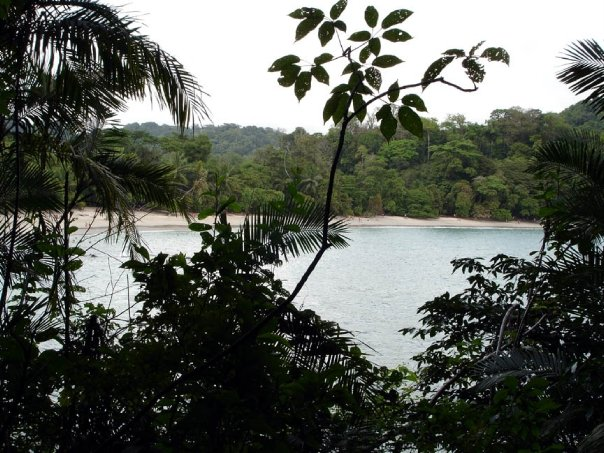
The Costa Rican government formally appropriated the land of Playa El Rey to Manuel Antonio National Park on November 17, 2000. This land added 14 kilometers of beach and increased the parks’ size to nearly 2000 hectares of land and 55000 hectares of marine area.
Click here and book your stay at one of our beautiful jungle villas!
The acquisition of Playa El Rey significantly extends the biological corridor of the National Park system to include the Naranjo, Portalón and Savegre rivers. This is in addition to the already protected areas including the central mountain range of Costa Rica, Cerro Nara Protected Zone, Los Santos Forest Reserve and The Quetzal National Park. The Chamber of Commerce of Aguirre is currently drafting a plan to incorporate Playa El Rey into the corridor to make this connectivity possible.“In effect Rio Naranjo is, what we hope to be, the start of an inter-oceanic biological corridor,” said Milo Bekins Faries, Forest Farmer and current chairperson of The Analog Forestry Network. “If you look at a map of all the protected areas in the country, this would mean that eventually the two biological corridors could connect Rio Naranjo and Rio Savegre to the Caribbean, Cahuito, el Golfito and even to the protected areas in Panama.”
The Ministry of Environment, Electricity and Telecommunications (MINAET) will play an important part in the development of the new biological corridor even though Bekins feels as though the government institution is underfunded. Bekins adds, “Our ACOPAC (conservation areas of Pacific Central) is the largest of the nine bio-regions in the country and is so important because they deal with environmental issues in our bio-region which go from sea level to 3,000 meters above sea level.” Bekins believes that the new protocol of involving communities and municipalities in the managerial processes in ACOPAC is a positive step forward.
The desired outcome for these vertical watersheds is to be connected to the Barú, Paquita, Parrita, Portalón and Savegre mountains (amongst others) and their ecosystems. With the hopes of finding similar groups working towards this goal, a system of increased communication between the people and government institutions has been created by The CORAC Regional Environmental Council of ACOPAC. The intent of initiating this social network of watershed groups is to find those who share interest in this venture and to get a head start on a superior system for the MesoAmerican biological corridor. This social network could then transform into corridor councils to lobby for connecting the biological corridor of Costa Rica’s National Park system to the MesoAmerican biological corridor.
In order for something this grand in its vision to take place, it will need the backing of many supporters, including non-governmental organizations from Costa Rica’s Pacific and Caribbean coasts. The support of these NGOs is necessary in order to restore their individual areas. To assist with the facilitation of legalizing the work of these NGOs and ensuring their appropriate funding, The Naranjo River Basin Council has been created.
Formed by community-based organizations, non-profits and NGOs, The Naranjo River Basin Council is currently undergoing the process necessary for legal constitution. Current NGOs participating in this event include water associations, The Titi Conservation Alliance, ACOMA, the development councils of Villa Nueva, Londres and Naranjito, ASOPROQUEPOS and PortaSol, amongst others. The Titi Conservation Alliance and ACOMA are already in partnership to educate children about the reasons why planting trees and creating buffer zones between river regions is so important.
Bekins hopes that carbon conservation will be one of the future benefits of this endeavor. Through the Payment for Environmental Services program, landowners can get involved by planting trees; in addition to the 35,000 trees that have already been planted along the Naranjo River watershed. With the help of local landowners, he hopes to one day be able to quantify the actual amount of carbon in the area. However, that is not the main purpose of this project. Bekins states, “The main benefit of extending the biological corridor will come from the future gene pool flow of biodiversity to and from Manuel Antonio National Park, which is an isolated “Biological Hot Spot”, along the watersheds to connect with the bio-diverse protected areas of the altitudinal forests.”
For more information, contact Milo Bekins Faries at mwbekins@racsa.co.cr or visit www.analogforestrynetwork.org.
